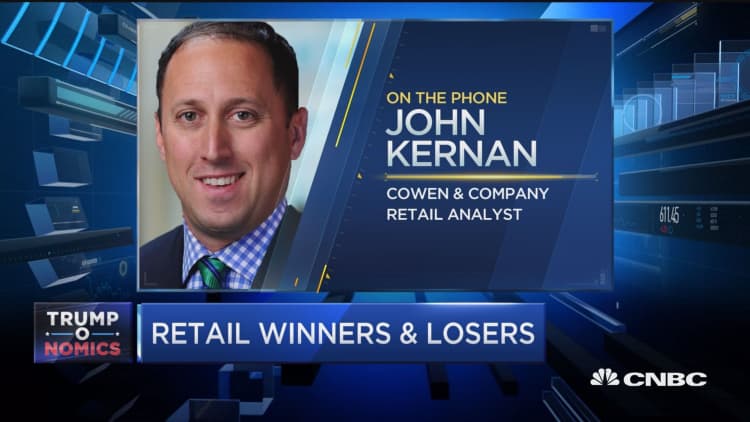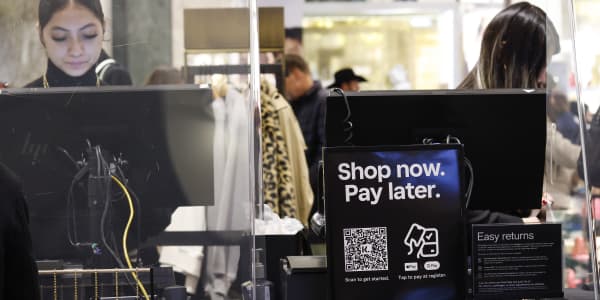
When retailers' sales reports trickle out in the new year, they'll be hard-pressed to find an excuse if their results fall short.
Buoyed by strong economic fundamentals, more confident consumers and a last-minute spending surge, several industry groups are now saying the season could come in at the high end or above their original forecasts.
That includes Customer Growth Partners, a well-known research firm that earlier this week raised its prediction from 4.1 percent growth to a 4.9 percent increase. If that bar is hit, it would mark the biggest yearly gain since 2005.
But while the backdrop of a stronger economy and chillier weather should give the broader industry a lift, it will also make it clear who's falling behind.
"Not everyone's going to have a good year," Greg Portell, lead partner in the retail practice of A.T. Kearney, told CNBC.
"What'll be interesting this time is that they won't be able to blame the consumer or consumer trends for poor performance," he said, referring to higher consumer confidence readings and lower unemployment. "This is really about how did they execute as merchants and retailers more so than an uncertain economic environment."
As cooler temperatures sweep across the Northeast, one of 2015's most popular excuses — the weather — doesn't hold much water this season. After last year's warm winter forced retailers to slash prices on coats and scarves, temperatures have been more cooperative this December. That, along with leaner inventories, has allowed retailers to sell more cold-weather merchandise at a higher margin.
Apparel stores in markets east of the Mississippi River received a $309 million boost in December thanks to these cooler temperatures, according to Planalytics, a firm that studies the impact of weather on businesses.
"Weather has been a convenient excuse for many retailers the last few years when what was really happening was a fundamental shift in the retail landscape," Steve Barr, PwC's US Retail and Consumer Sector Leader, told CNBC. "The 2016 holiday confirmed that the retailers having challenges will either need to transform, or they will no longer be relevant."

Much like the weather, using the recent presidential election as an excuse doesn't carry much weight. Although this distraction got the season off to a slow start, concerns that political uncertainty and fewer retail commercials could weigh on sales were quickly shot down. Because the results were tallied during the first few days of the official shopping season, industry analysts and several CEOs agreed that the election simply pushed sales later.
That thesis could be backed up by Johnson's observations. He noted that sales picked up after Nov. 10 and — save for the typical lull after Cyber Monday — remained steady. The season ended on a particularly high note, Johnson said, explaining the extra Saturday before Christmas drove shoppers out en masse. That momentum continued the day after Christmas, which was a federal holiday.
"It finished very strong," Barr said. "While there were distractions throughout the holiday season, whether it be weather or the election ... consumer sentiment remained strong."
Not everyone is as optimistic about the holiday season, with several Wall Street analysts noting depressed traffic at the mall. Yet whether or not sales beat expectations, most agree there will be clear winners and losers.
Though visits to traditional malls are down, traffic to stores like TJX and Home Depot has been better. Data from Slice Intelligence, which scans online shopping receipts, found that Best Buy, Target, Apple, Kohl's and Home Depot all grabbed a larger share of digital spending from Nov. 1 through Dec. 16.
Athletic wear companies Adidas and Lululemon have also been called out as winners, thanks to differentiated product that allows them to avoid the discounting game. Health and beauty stores — in particular, Ulta — are also seen turning in strong results.
On the flip side, general merchandise and department stores have been laggards, Johnson's research finds. PwC's Barr added that retailers who were forced to rely on high, unsustainable promotion levels fell short.
"The retailers that are stuck in the middle really did not do well, and the majority of their growth was fueled by promotions," he said.
Markets will have a better sense of how the industry performed when retailers including L Brands and Gap report December sales next week. That month's figures will be released by the Commerce Department the following week, with the National Retail Federation's total season tally coming shortly after.
NRF, the industry trade group, forecast sales would increase 3.6 percent in November and December.




